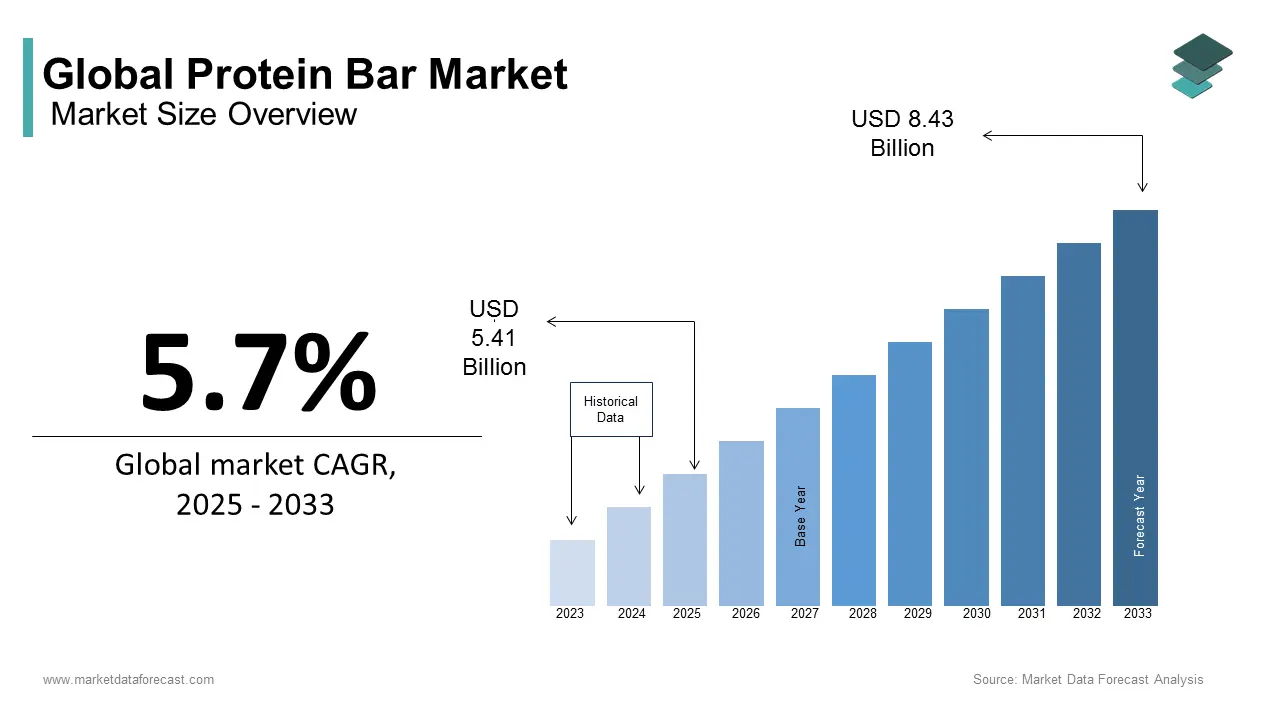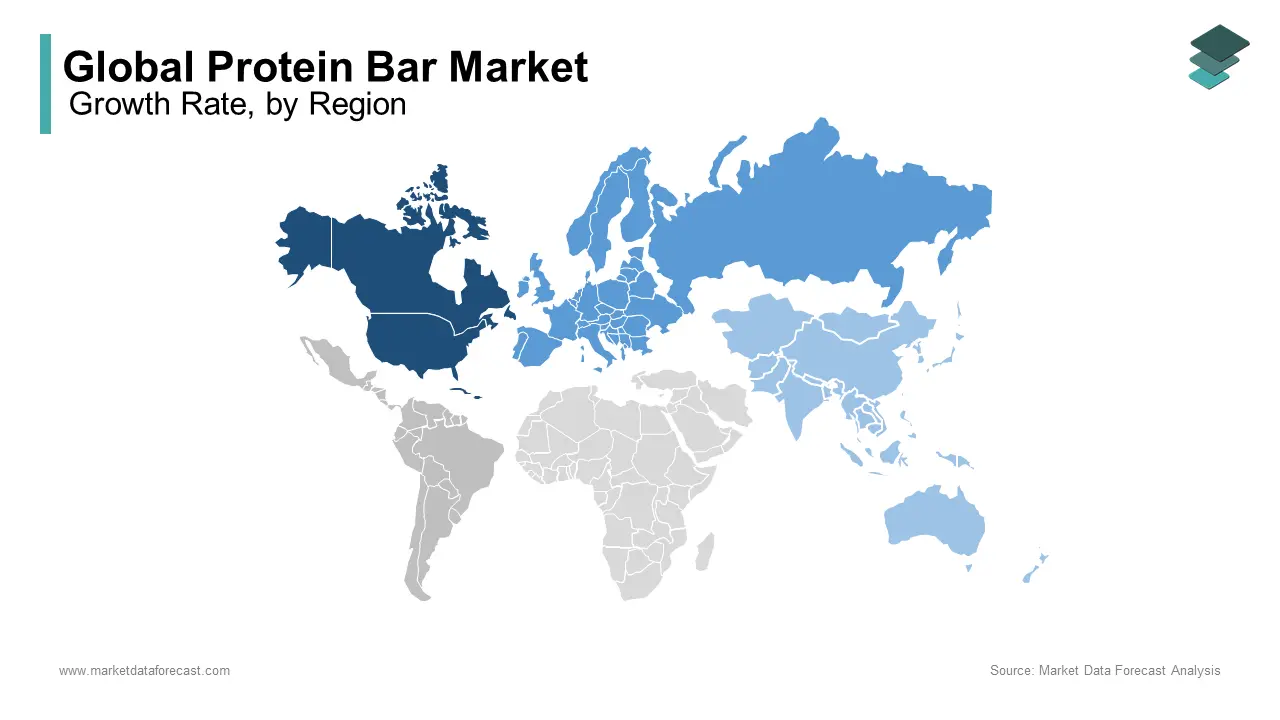Global Protein Bar Market Size, Share, Trends & Growth Forecast Report – Segmented By Product Type (Meal Replacement Bars, Energy Protein Bars, Low Carbohydrate Protein Bars And Women's Protein Bar), Protein Source (Plant Protein And Animal Protein), Protein Content (Low Protein, Medium Protein And High Protein) And Region (North America, Europe, Asia Pacific, Latin America, And Middle East & Africa) - Industry Analysis (2025 To 2033)
Global Protein Bar Market Size
The size of the global protein bar market was valued at USD 5.12 billion in 2024. The global market size is expected to grow at a CAGR of 5.7% from 2025 to 2033 and be worth USD 8.43 billion by 2033 from USD 5.41 billion in 2025.

The expanding interest in accommodation foods is driving the protein bar market. The significant shoppers incorporate game competitors, yet in addition the individuals who need to have a healthy supper without the difficulty of cooking. Shoppers lean toward purchasing protein bars for different purposes, for example, weighting the executives, improving bulk, and expanding vitality. In addition, promoting efforts for protein bars as a substitute for feast substitution by the wellness clubs has raised the deals of these items. With an expanding number of fitness centers and flooding mindfulness about protein bars, the market is relied upon to observe an ascent during the estimated time frame.
MARKET DRIVERS
The growing fitness trends are resulting in the growing adoption and increasing demand for protein-rich diets are primarily driving the global protein bar market growth.
Protein is a significant component that bolsters wellness progress. In this way, shoppers are deciding on weight on the board and vitality items, such as protein bars, to stay fit and healthy. Attributable to their high food levels, protein bars are picking up noticeable quality among the well-being cognizance shoppers. Moreover, these nutritious items can give the perfect protein balance required for a healthy way of life. Besides, enhancing suppers with bars is relied upon to expand protein admission without including pointless calories or starches. These wellness patterns are relied upon to expand the interest in protein bars, as they assume a significant job in giving basic supplements and proteins, expanding vitality levels, and improving bulk.
The rapidly growing demand for protein bars in developed countries is further boosting the growth rate of the global market.
The North American protein bar market is almost reaching its saturation, while the European and Asia-Pacific areas are intensifying in terms of manufacturing and usage. Europe had 26% of the global protein bar market in 2016. Sound tidbits and food supplements are on the ascent, with a high-protein bar brand exhibiting gigantic achievements in the United Kingdom and China. Characteristic and non-GMO protein bars are expected to turn into the top-rated healthy protein bars in the European and Asia-Pacific markets. The impact of Asia is expanding in the protein bar market, with expanding potential and item advancement in China, India, and different nations.
The growing awareness of healthcare and well-being among people is fuelling the protein bar market growth.
Due to protein inadequacy, several people have been facing various health difficulties worldwide. Furthermore, the accessibility of protein bars containing diminished allergen and gluten-free substances is another factor supporting the growth of the protein bars market worldwide. The rise in wellness patterns among males and females has expanded the need for protein bars, as they assume a significant job in giving fundamental protein supplements, increased vitality levels, and enhanced bulk. Accessibility of protein bars with different protein and calorie content combined with taste contrasts is additionally expected to build interest for protein bars in the market over the forecast period. Advancements in the flavor of protein bars can assist with expanding the buyer base tremendously and this can open potential income doors for target players in the market.
MARKET RESTRAINTS
High prices of protein bars and the huge accessibility of modest substitutes in the market are majorly hindering the growth of the global market.
REPORT COVERAGE
|
REPORT METRIC |
DETAILS |
|
Market Size Available |
2023 to 2032 |
|
Base Year |
2023 |
|
Forecast Period |
2024 to 2032 |
|
CAGR |
5.7% |
|
Segments Covered |
By Product Type, Protein Source, Protein Content and Region |
|
Various Analyses Covered |
Global, Regional & Country Level Analysis; Segment-Level Analysis, DROC, PESTLE Analysis, Porter’s Five Forces Analysis, Competitive Landscape, Analyst Overview of Investment Opportunities |
|
Regions Covered |
North America, Europe, APAC, Latin America, Middle East & Africa |
|
Market Leaders Profiled |
Small Planet Foods, Inc., The WhiteWave Foods Company, The Kellogg Company, General Mills, Inc., Premier Nutrition Corporation, Caveman Foods LLC, MARS, Incorporated, and Others. |
SEGMENTAL ANALYSIS
Global Protein Bar Market Analysis By Product Type

The energy protein bars segment is leading with the largest share of the market owing to the growing number of people showing interest in fitness activities. Most energy bars are made up of natural ingredients along with some synthetic additives that boost instant energy to make intense workouts like in the gym. The low carbohydrate protein bars segment is expected to hit the highest CAGR by the end of 2029. These protein bars are manufactured with cereals and micronutrients in various flavors and intend to supply instant energy. These products are slightly different from functional foods due to their low carbohydrate content. People who seek to follow a strict diet by limiting their carbohydrate intake can rely on these bars, which are augmented to leverage the growth rate of this segment in the coming years.
Global Protein Bar Market Analysis By Protein Source
The plant protein segment is gaining huge traction over the growth rate of the market. The trend toward the quick adoption of plant-based food products is effectively prompting the growth rate of the market. Soy and peas are major components used in manufacturing plant protein bars due to their effective textural properties. The animal protein segment has had the highest growth rate in the past few years and is expected to continue with the same flow throughout the forecast period. The prominence of eating protein bars in the regular diet for athletes is the most important way to boost instant energy while doing exercises.
Global Protein Bar Market Analysis By Protein Content
The medium protein content segment is attributed to holding the prominent growth rate during the forecast period. The launch of various protein bars according to the specified range to get easy approvals from government organizations slightly elevates the growth rate of the market. The high protein content segment is likely to have the highest growth rate during the forecast period. Penetration of the online stores where the delivery of the food products to the doorstep has become very easy, and it is sustainable to elevate the growth rate of the market
REGIONAL ANALYSIS

In the Americas, the locales centered are North America, the US, Canada, and Mexico, followed by Europe, including Germany, the UK, Spain, France, Italy, and the Rest of Europe, while Asia-Pacific involves districts like India, Australia and New Zealand, China, Japan and the remainder of Asia-Pacific separately. The rest of the world (RoW) contains the districts of the Middle East, South America, and Africa individually. The European market is determined to be valued at about USD 539.3 million by 2024. Additionally, the United Kingdom represented the most extreme part of the provincial market in 2018. Expanding well-being responsiveness is pushing market players to accentuate R&D to present solid dinner choices or bars with high protein sustenance in the European market. However, the Asia-Pacific market is probably going to show the highest CAGR over the conjecture time frame, with India being the quickest developing market.
KEY PLAYERS IN THE GLOBAL PROTEIN BAR MARKET
Companies playing a key role in the global protein bar market include Small Planet Foods, Inc., The WhiteWave Foods Company, The Kellogg Company, General Mills, Inc., Premier Nutrition Corporation, Caveman Foods LLC and MARS, Incorporated.
RECENT HAPPENINGS IN THE MARKET
- In March 2019, Trek, a conspicuous brand of Natural Balance Foods, propelled a protein nut bar extension. The item is available in blueberry and pumpkin seed, dark chocolate and sea salt, coconut and raspberry, and orange and coconut flavors. The item dispatch expects to target buyers who search out nutritious and scrumptious snack items.
- Herbalife Nutrition in August 2018introduced 'Herbalife24 Achieve Protein Bar', its first-ever protein bar. The item professes to be huge for muscle modification, exercise recuperation, and others.
- General Mills Inc. propelled an exhaustive rundown of new items out of which in the protein bar class they propelled.
- Nature's Bounty Co. purchased The Best Bar Ever, a renowned provider of gluten-free protein bars.
- ThinkThin banded together with the association V-WISE ahead of preparing programs for enterprise and private ventures on the board.
DETAILED SEGMENTATION OF THE GLOBAL PROTEIN BAR MARKET INCLUDED IN THIS REPORT
This research report on the global protein bar market has been segmented and sub-segmented based on product type, protein source, protein content and region.
By Product Type
- Energy Protein Bars
- Women's Protein Bar
- Meal Replacement Bars
- Low Carbohydrate Protein Bars
By Protein Source
- Plant Protein
- Animal Protein
By Protein Content
- Low
- Medium
- High
By Region
- North America
- Europe
- Asia Pacific
- Latin America
- Middle East and Africa
Frequently Asked Questions
1. What factors drive the growth of the protein bar market?
Factors driving market growth include increasing consumer health and fitness awareness, growing demand for convenient and nutritious snack options, rising interest in protein-rich diets, expanding product innovations, and the influence of social media and fitness trends.
2. What are the challenges facing the protein bar market?
Challenges include competition from other protein-rich snacks, consumer concerns about artificial ingredients, sugar content, and taste preferences, regulatory considerations related to labeling and health claims, and the need for continuous product differentiation and innovation.
3. What are the key ingredients typically found in protein bars?
Protein bars typically contain protein sources such as whey, soy, pea, or other plant-based proteins. Depending on the specific product and target audience, they may also include carbohydrates, fats, fibers, vitamins, and minerals.
Related Reports
Access the study in MULTIPLE FORMATS
Purchase options starting from $ 2500
Didn’t find what you’re looking for?
TALK TO OUR ANALYST TEAM
Need something within your budget?
NO WORRIES! WE GOT YOU COVERED!
Call us on: +1 888 702 9696 (U.S Toll Free)
Write to us: [email protected]